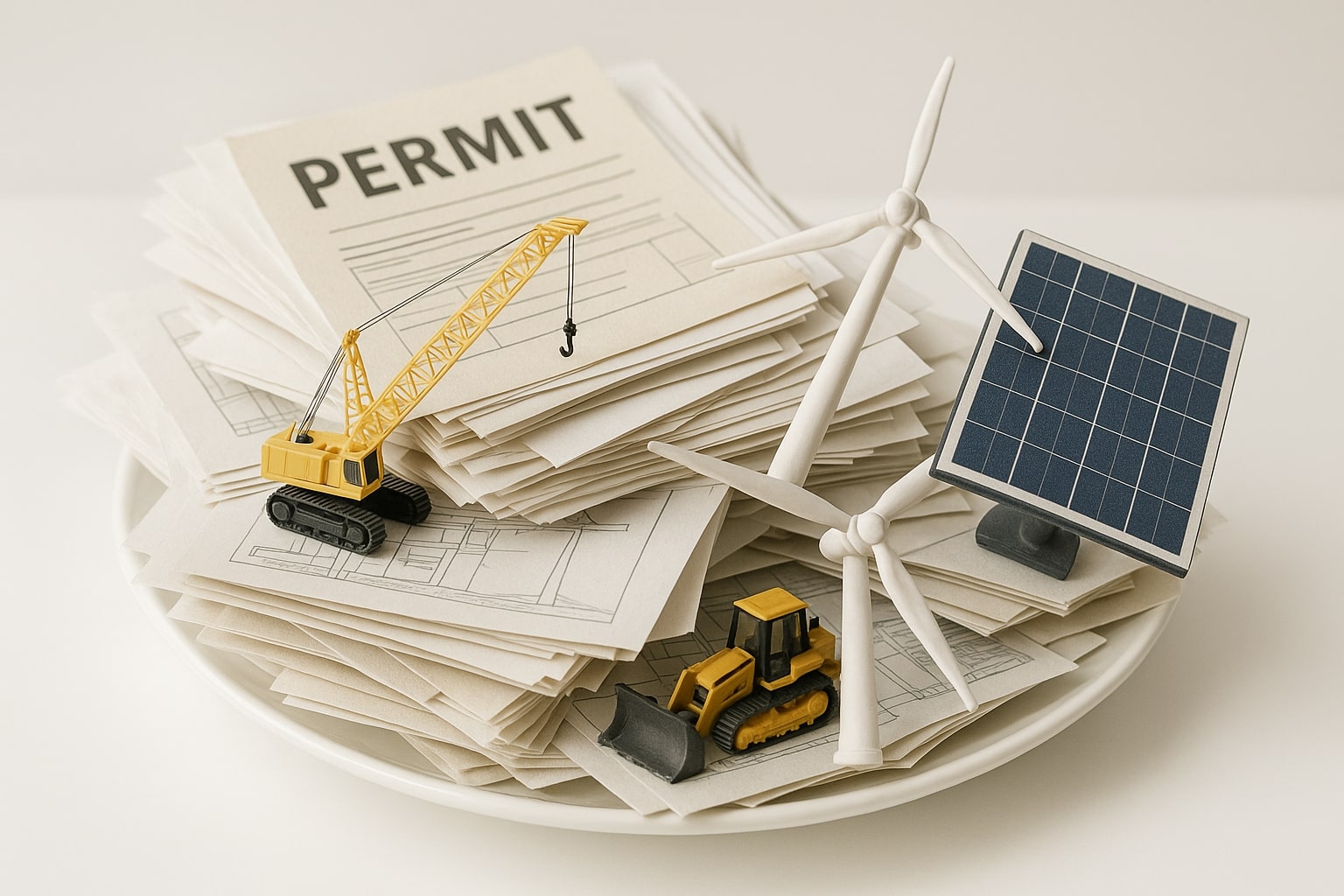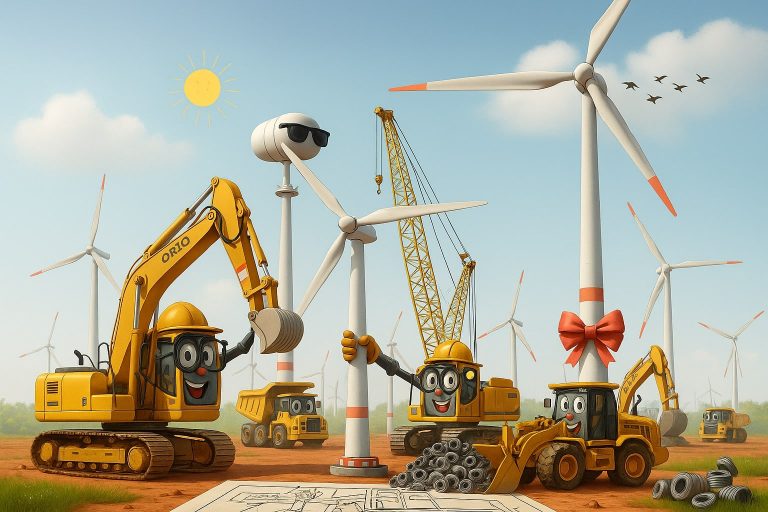What do a dusty field, a maze of permits, and a glitchy spreadsheet have in common?
They’re not just symbols of bureaucracy. They’re the birthplace of clean energy.
Every solar farm, wind turbine, or battery bank begins not with sunshine or wind—but with questions, paperwork, and people. It’s easy to think renewable energy is just about plugging into nature. But the real story? It’s a long, tangled journey that often spans decades.
The future isn’t built in labs. It’s built in town halls, planning rooms, and spreadsheets.
Before the first foundation is poured, teams must scout land, woo regulators, win over investors, and occasionally soothe worried neighbors. And here’s the kicker: most projects never make it past this stage. Not because the tech doesn’t work, but because the system around it breaks down—permits stall, funding collapses, or a migrating bird reroutes everything.
That’s why understanding the entire lifecycle—from sketch to shutdown—matters. Not just for engineers or policymakers, but for everyone who flips a switch, pays a utility bill, or wonders what kind of future we’re wiring ourselves into.
In this guide, we’ll walk through the six critical stages of renewable energy development. We’ll skip the jargon, lean into the stories, and open up the process in plain, human terms.
So if you’ve ever looked at a solar panel and thought, “How does this happen?”—you’re in the right place.
Welcome to 1000whats. Let’s plug in.
Key stages of renewable energy project development
Every bold energy project begins the same way: with a question whispered in a meeting room or scribbled on a napkin—“Could this actually work?”
What follows is far more than a checklist. It’s a living process—a series of decisions, setbacks, and breakthroughs that stretch from raw idea to real-world impact. At the end of the line, someone has to ask another question: “What now?”
From spark to sunset, every energy project tells a story—if you know where to look.
Below, you’ll find that story told in six acts. This isn’t just a timeline. It’s a window into why each stage matters.
Project stages overview
| Stage name | Purpose | What happens | Key milestone |
| 1. Conception & Feasibility | Decide if the project is worth pursuing. | Site scouting, resource checks, environmental scans, and early financial modeling. | Go/No-Go decision based on feasibility and potential success. |
| 2. Structuring & Regulatory Alignment | Set legal, financial, and regulatory foundations. | Define ownership, permits, grid access, and regulatory roadmap. | Structure agreed, permits outlined, and utility talks begun. |
| 3. Refinement & Financial close | Secure funding and lock in the plan. | Deep financial modeling, finding money (equity, debt, grants), choosing vendors, and sealing deals. | Financial close: contracts signed, project now “bankable.” |
| 4. Implementation & Commissioning | Turn the plan into physical reality. | Construction starts, equipment goes in, systems connect to the grid, and performance is tested. | Operational status: permission to run is granted. |
| 5. Operations & Maintenance | Keep it running well and profitably. | Monitor output, fix issues, manage warranties, and track financial and technical performance. | Sustained output and efficiency confirmed. |
| 6. End-of-life management | Retire or repurpose the project. | Plan decommissioning, recover materials, restore land, or upgrade systems for a new life. | Land restored or project repowered for future use. |
No project lasts forever. But the best ones leave behind more than just infrastructure—they leave insight, resilience, and sometimes, a ripple of inspiration.
Whether they fade into quiet retirement or rise again through reinvention, these energy projects write a story. Not just in kilowatts, but in hard-won lessons, community shifts, and the steady hum of something that once didn’t exist.
Even when the lights go out, the story isn’t over.
Now that we’ve zoomed out to see the whole journey, it’s time to dive in. Let’s walk through each stage of development—what really happens, who shapes it, and where the hidden challenges lie.
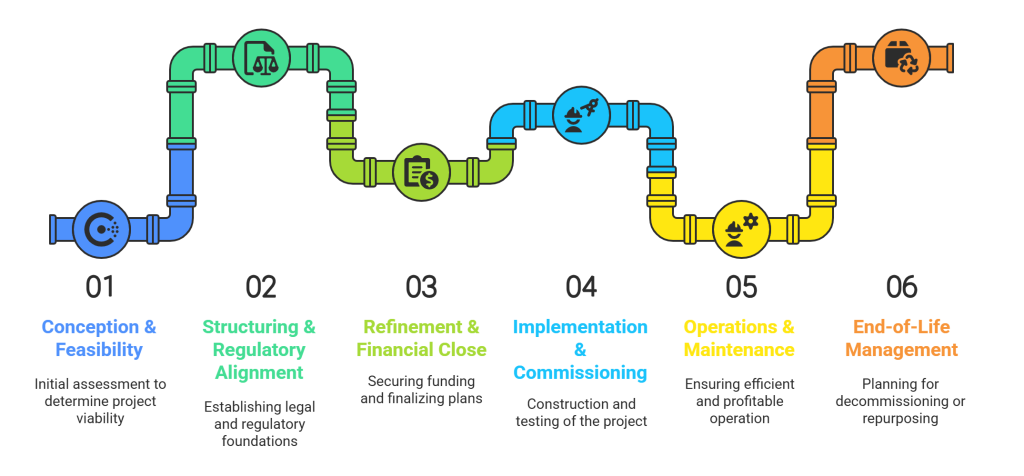
Stage 1: Conception & Feasibility — Can this project really work?
Before a single panel glints in the sun or a turbine catches the breeze, there’s a sobering question every developer must ask: Is this even possible?
This stage is the proving ground. The audition round. Dreamers walk in with bold visions. But only the grounded, viable ones earn a second look.
This is where imagination meets spreadsheets—and not everyone survives the meeting.
In the Conception & Feasibility stage, teams dig into data, scout potential sites, study the grid, run preliminary financial models, and chase down early red flags. They ask: Is the land right? Will regulators play ball? Are the numbers even close to working?
It’s like a pre-flight checklist for renewable energy. You don’t want surprises later at 10,000 meters.
And here’s the hard truth: most projects don’t make it past this stage. Not because they’re bad ideas—but because reality steps in early. A rare bird species, an unfriendly zoning board, or a mismatched transmission line can quietly shut the whole thing down.
Still, this stage matters deeply. It filters out the wishful thinking and pushes the best ideas one step closer to becoming real power in the world.
🔎 Site selection and resource assessment
It all starts with location.
Is there enough wind? Sunshine? Can the land physically support the infrastructure?
Tools like PVWatts help model solar output, while wind developers turn to topographical maps and meteorological data.
But it’s not just about resource availability—developers also scout for land with minimal slope (no more than 5% for solar, under 20% for wind), few ecological sensitivities, and existing infrastructure.
Interestingly, many projects now prioritize the “built environment”—like rooftops and parking lots—or compromised land such as capped landfills. Why disturb pristine fields when you can turn yesterday’s trash into tomorrow’s energy?
📈 Energy load analysis and system sizing
“How much do we need—and can the system handle it?”
Developers study electricity bills and usage patterns to size the system just right. It’s part forecast, part engineering. They check how much power is needed, what the grid can support, and where limits like net metering kick in.
Too small wastes potential. Too big hits a wall.
The goal? A system that fits like a glove—now and in the future.
⚙️ Technology evaluation
Is solar the right choice, or does wind offer better returns?
Choosing the right tech isn’t just about sunlight or wind speeds. It’s about what fits financially, politically, and practically.
The best tech isn’t the fanciest—it’s the best fit.
Developers weigh costs, incentives, site conditions, and scale to pick the winner. The goal? Right tech, right place, right price.
Before building begins, every project must pass a gauntlet of environmental checks—land use, wildlife, water, noise, and more.
One overlooked detail can stall a project for years.
Some permits come quickly. Others demand years of studies and hearings. It all depends on the site, scale, and impact.
For developers, this stage is a tightrope. Miss a step, and the whole project can fall. That’s why smart teams plan early and bring in seasoned guides to navigate the maze.
💸 The funding gap
Here’s the brutal truth: most projects don’t fail because of bad ideas—they fail because of a lack of early-stage capital.
This “valley of death” between idea and financing is especially harsh for smaller or local developers. Without targeted financial tools, even the best ideas can stay stuck in PowerPoint purgatory.
If Stage 1 is about proving an idea is possible, Stage 2: Structuring and Regulatory Alignment is about proving it’s legal, bankable, and built to last.
This is where big dreams meet hard structure. Projects now need legal clarity, ownership models, permits, and a green light from the utility.
Here, deals are drafted, rules are navigated, and everything must line up—from land rights to interconnection agreements. Many solid projects stumble right here, tangled in red tape or stuck in regulatory limbo.
Get this stage right, and you’re no longer pitching an idea. You’re building a business.
👥 Choosing the right ownership structures and business model
Who owns the project? Who takes the risk? Will the local tribe be the landowner, operator, or power purchaser?
Ownership isn’t just a legal formality. It shapes power—literally and figuratively.
Some players lease land or buy energy with minimal risk. Others take deeper roles—as developers, investors, or operators. And in some cases, local communities or tribes lead the charge.
The model you choose defines control, liability, and long-term benefits. Get it wrong, and even a great project can turn into a costly headache.
📜 Permitting and site use approvals
Let’s talk red tape.
Renewable energy projects can require a mind-bending array of permits—local, state, tribal, and federal. Everything from environmental impact statements to historic preservation must be reviewed.
Skipping a step? Not an option. Forgetting one? It could delay a project by years.
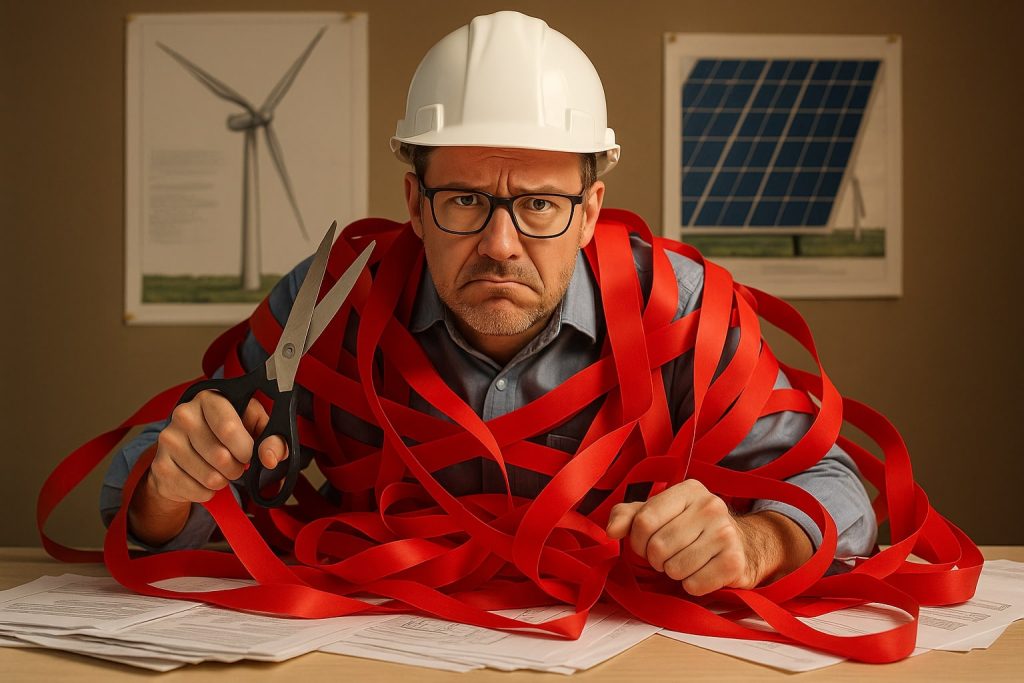
⚡ Grid interconnection
If there’s one thing that keeps renewable developers up at night, it’s this: getting connected to the grid.
It’s not just about plugging in—it’s a maze of red tape, engineering studies, and queue delays. And it’s not just the local distribution system anymore. Larger projects need access to high-voltage transmission, which comes with stricter rules, longer timelines, and massive upgrade costs.
The interconnection queue? Years long in many regions. By the time you’re approved, your permit might have expired or your investors might be gone.
Bottom line: grid interconnection is one of the biggest obstacles in renewable energy today—and it’s only getting messier.
🧩 Environmental and permitting hurdles
In Stage 1, developers flagged potential environmental issues. Now, those red flags become real paperwork—and real pressure.
At this stage, teams submit formal reports, hold public consultations, and chase permits. Requirements vary by region—from wildlife assessments to cultural heritage reviews. Some projects fly through. Others get stuck for years.
This isn’t just filing forms. It’s survival strategy.
But make no mistake: these aren’t optional steps. Miss one requirement, and the whole timeline can unravel.
The smart move? Start early and hire pros. Environmental approvals aren’t just about compliance—they’re a frontline defense against risk.
The bottom line? Stage 2 is about getting your legal and logistical ducks in a row. Miss a step, and you risk delay, denial, or disaster. Get it right, and you’re one giant step closer to turning your idea into a clean energy reality.
Stage 3: Refinement & Financial Close — What makes a renewable energy project “bankable”?
You’ve cleared feasibility. You’ve battled through permits. Regulators gave the nod. Now comes the moment of truth: Will anyone write the check?
This stage isn’t about dreaming—it’s about delivering confidence.
Refinement & Financial Close is the final pitch. Developers must convince investors the project is real, reliable, and ready. Contracts get finalized. Risks get priced. And everything—from tech specs to insurance—is locked down.
Miss a detail here, and the whole thing stalls. Nail it, and you’re cleared for launch.
📊 Modeling the money
This stage kicks off with serious number crunching. Developers build detailed financial models that account for every dollar—land leases, grid upgrades, insurance, maintenance, and more.
Investors don’t fund dreams. They fund math.
They also forecast revenue—based on energy prices, incentives, and power purchase agreements. The goal? Show that the project won’t just work—it’ll pay off. Predictably. Consistently. Convincingly.
💸 Locking in the capital
To get to financial close, developers typically piece together a cocktail of funding sources:
- Equity: Investors exchange capital for a share of the project.
- Debt: Loans from banks or development finance institutions.
- Grants & Incentives: Often from governments, utilities, or international climate funds.
- Tax credits (where available): Can significantly improve project economics.
- Innovative tools: Like performance contracts or green bonds, especially in emerging markets.
But here’s the hard part: early-stage funding is still a massive global bottleneck, particularly for local developers. Many solid projects never make it this far because they can’t cover the cost of studies, applications, or even legal fees.
🤝 Vendor selection and final permits
At the same time, teams are issuing RFPs (requests for proposals), selecting contractors, negotiating terms, and locking in key vendors.
This stage also includes finalizing environmental permits and interconnection agreements. Everything has to line up—no loose ends allowed.
✅ Financial close
Once contracts are signed and funding is locked in, the project reaches financial close. That’s the official green light. Money moves, timelines firm up, and construction begins.
Getting here can take years—not for lack of tech, but because capital moves slowly.
Many projects stall right here. Not because the ideas are weak, but because financing clean energy is still harder than building it. Financial close isn’t the end of planning—it’s the start of reality.
Stage 4: Implementation & Commissioning — How are these projects actually built and switched on?
After years of planning, approvals, and financing, Stage 4 is where the rubber meets the road—or more accurately, where the turbines meet the sky and the panels catch their first rays of sunlight.
This is the most visible—and often most expensive—stage of the entire renewable energy project lifecycle. It’s also where everything that’s gone right (or wrong) in earlier stages becomes painfully obvious.
🔧 Pre-Construction: Setting the stage
Before the first shovel hits dirt, the site becomes a hive of preparation. Kickoff meetings, construction docs, logistics plans, and grid coordination all come together.
The interconnection process—often started earlier—is now in full swing, as utilities review and approve final grid integration steps.
This is also when developers prepare for supply chain realities: long lead times, delivery schedules, and (unfortunately) unexpected delays.
🏗️ Construction and installation
Now comes the heavy lifting.
Construction teams build foundations, erect turbine towers, install solar arrays, string inverters and cabling, and connect everything to substations or transformers. This stage often involves an EPC contract (Engineering, Procurement, and Construction), where one entity oversees it all.
Every bolt, beam, and breaker matters—because quality control now will determine performance for decades.
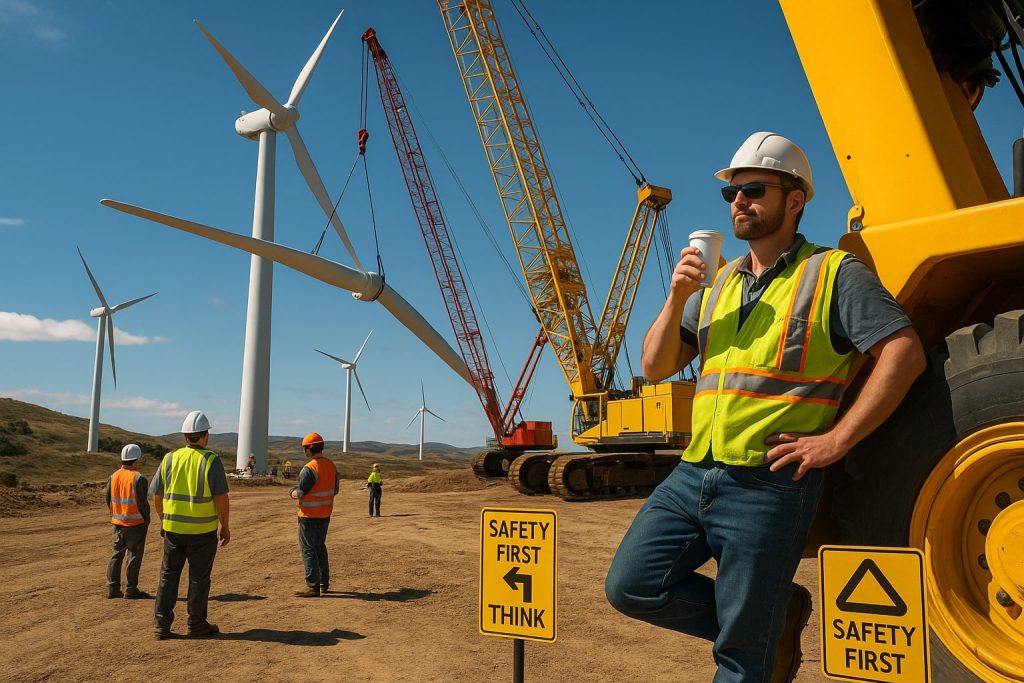
🔌 Grid interconnection and system testing
Once built, the project must be safely and successfully connected to the grid.
Utilities inspect the site, review documentation, and run system tests. Only after everything passes do they grant the golden ticket: Permission to Operate. That’s when the energy starts flowing—for real.
✅ Commissioning: Proving it works
Commissioning is where the project proves itself. Teams run performance tests—Is it generating as promised?—and safety checks—Is everything compliant and secure?
It’s not a formality. It’s a filter.
This is the last chance to catch flaws, fix bugs, and fine-tune the system before energy flows to the grid. Miss something here, and it costs far more later.
🧯 Managing risk and reliability
Even with everything in place, projects can face delays due to supply chain hiccups, equipment failures, or workforce shortages.
That’s why experienced teams build buffers into budgets, timelines, and tech.
Because once the switch is flipped, the system can’t blink. It has to deliver—day after day, year after year.
Stage 5: Operations & Maintenance — What keeps these systems running for 20+ years?
The system’s live, power’s flowing, and the hard hats are gone. But now begins the longest—and most crucial—chapter: making it all last.
Stage 5: Operations & Maintenance (O&M) is where renewable energy becomes a true utility-scale asset. This is about more than just fixing broken parts—it’s about protecting performance, ensuring returns, and maximizing lifespan.
Welcome to the part where renewables earn their keep—day in, day out, for decades.
🖥️ Real-time monitoring
Today’s solar farms and wind projects are digitally connected, constantly feeding data into performance dashboards.
Operators can monitor output, efficiency, weather conditions, and even component temperatures—all in real time.
When a turbine underperforms or a solar string blinks out, alerts go off instantly. The goal? Catch issues early, fix them fast, and keep every watt working.
🧰 Preventive vs. corrective maintenance
Preventive maintenance is like brushing your teeth—it keeps things working longer and avoids bigger issues. That includes routine inspections, cleaning solar panels, tightening bolts, replacing filters, and software updates.
Corrective maintenance, on the other hand, kicks in when something fails—an inverter shorts out, a panel cracks, or a turbine bearing wears down. The faster teams respond, the less energy (and money) is lost.
📝 Warranty & contract management
Most major components—solar panels, inverters, turbines—come with long warranties (20+ years for panels, 10+ for inverters). Managing these contracts ensures that repairs and replacements don’t hit your wallet when they shouldn’t.
Equally important: sticking to power purchase agreements (PPAs), O&M service contracts, and regulatory reporting requirements. Paperwork may not be sexy, but it protects your revenue.
🔧 Performance optimization
O&M teams are constantly fine-tuning operations to squeeze every extra kilowatt-hour out of the system.
This might mean cleaning panels after a dust storm, recalibrating wind turbine yaw angles, or upgrading software to boost efficiency.
💰 Admin and financial oversight
Behind every watt is a web of paperwork.
Operations aren’t just in the field—they’re at the desk, too. Teams manage billing, budgets, insurance, reporting, and vendor coordination.
Good admin keeps the lights on—and the numbers in the black.
Strong oversight means fewer surprises, faster payouts, and a healthier, more profitable asset.
The takeaway? Great O&M doesn’t just keep the lights on—it extends system life, protects investor returns, and lays the groundwork for repowering or resale.
Stage 6: End-of-Life Management — What happens when a renewable project reaches retirement?
Even the most reliable systems reach their final chapter. But in renewable energy, that chapter might start a whole new book.
Stage 6: End-of-Life Management is where project owners decide: do we retire the system or repower it for another cycle?
End-of-life planning is more than shutting down operations. It’s a critical decision point that affects future returns, land use, and sustainability.
What happens next—decommissioning or upgrading—will echo for decades.
🧹 Decommissioning: Responsible retirement
When a project ends, it shouldn’t become a forgotten relic. Decommissioning ensures everything’s removed—safely, cleanly, and with care for the land.
Crews dismantle panels, turbines, cables, and foundations. Some parts get recycled—glass, aluminum, certain plastics. Others, like panels with trace metals, need safe disposal.
Financial safeguards, like bonds or insurance, help cover the cost—so the land isn’t just cleared, but honored.
⚡ Repowering: A new lease on (energy) life
Sometimes the smartest move isn’t retiring—it’s upgrading. Repowering gives aging projects a new lease on life with better tech and higher output.
A wind farm might swap old turbines for taller, more powerful ones. A solar site could install next-gen panels with better efficiency. Inverters, software, and sensors all get smarter.
Best part? The hard stuff—land, permits, grid ties—is already in place. That makes repowering cheaper, quicker, and less disruptive than starting from scratch. And for landowners? It means the checks keep coming.
🔁 Circular thinking
More projects now follow circular economy principles: reuse, repurpose, recycle. The goal isn’t just removal—it’s recovery.
End-of-life isn’t the end. It’s a design decision.
Smart developers plan for decommissioning and repowering from day one. That means designing systems that are easier to upgrade, dismantle, and recycle—turning the final stage into a new beginning.
So what happens when the turbines stop spinning? With the right planning, they might just start again—cleaner, quieter, and more powerful than before.
Final thoughts
Building renewable energy isn’t just a task—it’s a balancing act on a wind turbine blade. Every step, from napkin sketch to power switch, demands grit, brains, and a bit of weather-related swearing.
No stage works in isolation. Miss one, and the whole system wobbles like a solar panel in a hailstorm.
Clean energy isn’t just built—it’s earned, one spreadsheet and socket at a time.
There’s no silver bullet. No magical solar unicorn. Just smart design, community grit, and a refusal to settle for “the way it’s always been.”
So whether you’re an engineer, policymaker, or just someone who pays an electric bill—you’re part of this.
Now, I’d love to hear from you:
- Which stage surprised you the most?
- How is renewable development handled in your country or region?
- What financing models do you think could make energy more equitable?
- Would you be interested in exploring how repowering is reshaping old infrastructure?
Drop your thoughts in the comments, and let’s keep the conversation flowing. After all, renewable energy is a team effort—and knowledge is power.
Until next time, stay curious!
